|
|
|
Xunantunich
Monday, December 29 2014
location: Orchid Garden Resort Ecolodge, Hattieville, Belize
I slept badly last night due to marginal mechanical equipment in our room. The air conditioner made a horrendous rattle if asked to do anything more than gently cool the room, but if it wasn't on, there was nothing to mask the incessant ticking coming from the refrigerator. And occasionally the refrigerator's compressor would become unbalanced and lean against some resonant structure and make a dreadfully loud 60 Hz hum. Gretchen soon discovered that the sound would go away if she pounded on the side of the fridge. But that required getting out of bed.
Unlike our Curacao vacation from last year, our Belize vacation had been structured around visits to various sites throughout the country. Indeed, aside from supplying us a place to sleep and eat, it didn't really matter what Orchid Garden was like, since we'd be spending few of our waking hours there. Today the plan was for us to go horseback riding at a ranch belonging to a expat American rancher from Montana, though of course Gretchen still mostly just wanted to go swimming (and, having been exposed to it in my youth, I am not excited by horseback riding). So Alfredo had made special arrangements that would allow Gretchen and I to make use of a pool that happened to be at the horseback riding place while the others got to play cowboys.
First, though, we had to load into a van and be driven west half way to the Guatemalan border. Initially the landscape is completely flat, save for a strange ridge to the south of the Western Highway informally known as "the Sleeping Giant." It looks like a giant elite Mayan lying on his back: a body, a neck, a chin, a nose, and a sloping forehead rising unexpectedly steeply from the plain. As we approached it closer, it appeared to be an active quarry, suggesting that the possibility that the landform had been sculpted by humans (prehistoric or otherwise) to look the way it does.
The horseback riding ranch was part of a resort called Banana Bank situated in the north edge of a pocket of highlands in west-central Belize. It's a fancier place than Orchid Garden and, in addition to a smallish (but lovely) pool, features a number of captive animals such as peacocks and even a Jaguar. (Gretchen was concerned that perhaps the Jaguar was lonely, though at least she seemed healthy.) Gretchen and I set up immediately by the poolside with chaise lounges and our reading materials and then got into the comma-shaped manmade body of water. There was a rather dramatic pink stucco-and-stone-sided building along one side of the pool that looked initially like a church, though where a steeple might have been appeared to be a mobile retractable dome suitable for housing a telescope. We went back and forth between the water and the chaise lounges several times, just as we would have on the beach. Initially we had the pool all to ourselves, though eventually a few others showed up. Though it was small, it was big enough for our needs. Eventually the others in our party were done horseback riding and they joined us at the pool. The kids even went swimming, something our Orchid Garden minder indulged, though it wasn't part of the program.
We had lunch there at Banana Bank. It was angelhair pasta with red sauce, a salad of cucumbers and iceberg lettuce, and garlic bread that probably wasn't vegan (though we all ate it anyway). Though it didn't have much in the way of protein, it filled our stomachs and gave us energy.
Our next destination was very near the Guatemalan border, a Mayan ruin called Xunanthanich. To get there, we had to go to the village of San Jose Succotz and take a ferry across the Mopan River. The ferry was a primitive barge attached to a cable, and it was powered entirely by a single operator turning a crank attached to a winch that drew the skiff along the cable. With that modest source of energy, it was able to ferry a cargo consisting of our van, a couple horses, two children, and at least eleven adults in a single crossing.
At the entrance of Xunanthanich, we were given a tour guide who initially pointed out various birds, reptiles, and plants such the Strangler Fig. But then, behind the ruins of a smallish Mayan "administrative building," I could see the steep forested mounds of massive as-yet-unexcavated buildings. Somehow I'd expected the Mayan structures to have deeply alien forms, but no, they tended to be rectangular and have familiar-looking doorways, occasional window sills, and even built-in benches (all the roofs and wooden structures had been lost long ago). Surprisingly, there was a great deal of what looked like mortar between the bricks. Most of that was from recent restorations, though it turned out that the Mayans had made a material similar to Portland cement by baking the native limestone (the most common bedrock in Belize and the rest of the Yucatan) in wood fires. The overharvesting of that firewood was part of what eventually led to the collapse of Mayan civilization.
Our guide took us up to a green grass square (it rather reminded me of a similar such place at the University of Virginia) dominated on the south end by a massive stone pyramid. Supposedly the commoners amongst the Maya would gather in this square as elite priests would perform elaborate rituals to predict and alter the future. In that society, there was little in the way of science or technology, so everything had to be done with elaborate stagecraft and slight-of-hand (which is how religions go about demonstrating their power to this day). Eventually, though, the crowds apparently grew too big for the feeble stage-craft to bamboozle, and so the square was divided by a massive structure in its center.
After the explanation of these things, we were finally allowed to climb the steep steps of the 130-foot-tall pyramid, something that all of us did except for Gretchen's mother (who is still recovering from knee surgery). The two kids had very different attitudes about the climb, with my eight year-old niece charging ahead enthusiastically, snapping lots of pictures on her digital camera with its 21x optical zoom (a recent Chanukah present). By contrast, my eleven year old nephew was very anxious, particularly about the steep sets of stairs and narrow four-foot ledges lacking the sorts of handrails with which any self-respecting American attraction (ancient or contemporary) would have been equipped. Once we'd made it to the eastern shoulder of the pyramid, we could see an impressive low-relief friezes containing elaborate (and very alien) designs that looked more symbolic and stylized than representational. Our guide explained that these were actually fibreglass copies of the actual friezes, which the Maya had made of a fragile plaster. They'd been reburied for protection after they'd been copied. We didn't have long to marvel at the friezes before their thunder was utterly stolen by a small group of three or four Howler Monkeys who appeared in a nearby tree. We all went over to the look and take pictures, and while we were there they came down into the lower branches and were surprisingly close, having apparently no concerns whatsoever about American tourists (nearly everyone at the site was American except for the guides). Eventually we pried ourselves away (which was hardest of all for Gretchen) and proceeded to the very summit of the pyramid, where we had a spectacular view of the surrounding forests and villages, some of which were in nearby Guatemala. Guatemala's proximity posed enough of a security concern that green-outfitted members of the Belize military had been stationed throughout the ruins to guard against marauders hoping to steal artifacts or rob tourists of their valuables.
On the way back to our van, our guide pointed out a number of birds and trees, including one called Poisonwood that caused a rash similar to Poison Ivy and another that could be used as a medicine to cure that rash. That second tree is called Gumbo Limbo or, due to its pealing bark revealing a red underbark, "Tourist Tree" informally.
After taking the hand-cranked ferry back across the Mopan, our driver took us all the way to the Guatemalan border (a dusty several acres of taxis, vans, pedestrians, and dogs) to pick up a couple of other Orchid Garden tourists returning from Tikal.
On the drive back to Orchid Garden, we stopped somewhere for a few groceries and wound up also getting some more Belikin beers. Gretchen and I popped open a couple of them and drank them on the ride. I had the "Stout," which was more of a dark lager, and found it surprisingly good.
Dinner tonight at Orchid Garden was in the grandest of the several dining rooms, at a table so wide that passing items from our side (the Silver Spring and Hurley contingents) to the other (the Pittsburgh contingent) was difficult. Tonight the food was fairly good (I especially liked the mushrooms, which had evidently started out dried and been very slowly rehydrated) and came in copious courses, though it was devoid of any obvious protein component. Most of its oily complexity was lost on the kids, who still prefer such things as plain rice and pasta and, when they eat vegetables at all, prefer it uncooked and unseasoned. (I'm 46 and I still only like peas and carrots in their uncooked forms.)
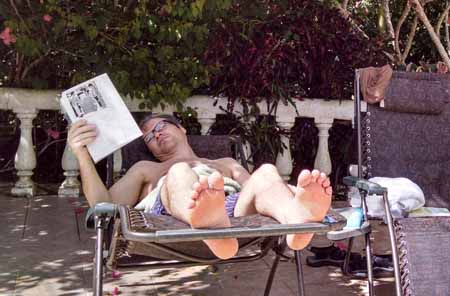
Me relaxing near the pool at Banana Bank. (Click to enlarge.)
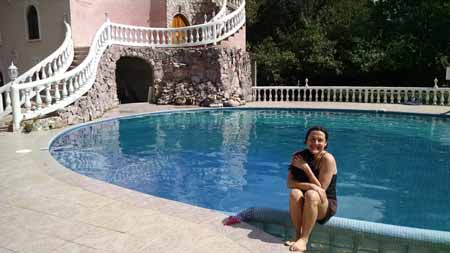
Gretchen near the Banana Bank pool with Tomas, a reasonably-friendly small black dog who kept walking through. (Click to enlarge.)
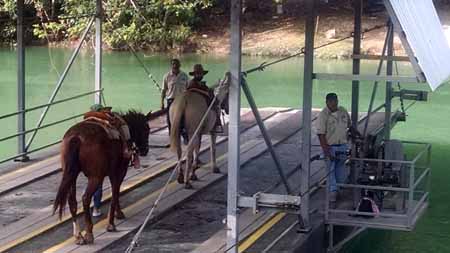
The hand-cranked ferry across the Mopan River. (Click to enlarge.)
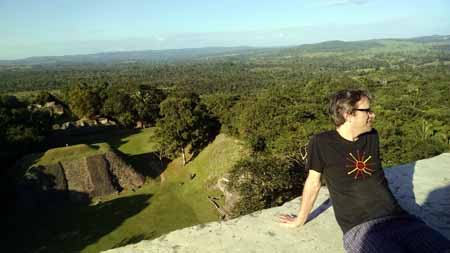
Me atop the main pyramid at Xunantunich, pronounced "shoo-nahn-tennich" (Click to enlarge.)
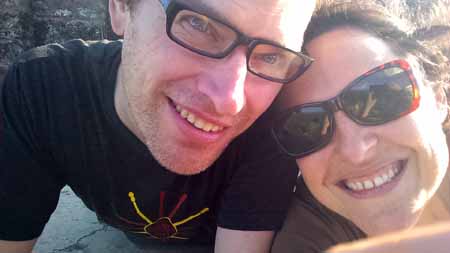
Gretchen and me in a selfie atop the main pyramid at Xunantunich.
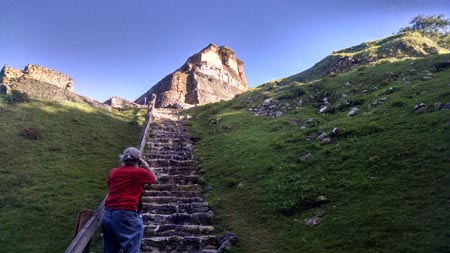
Gretchen's father looking back at the the main pyramid at Xunantunich from the west. (Click to enlarge.)
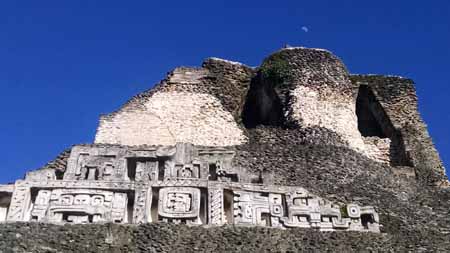
The main pyramid at Xunantunich from the west. Note the Moon. (Click to enlarge.)
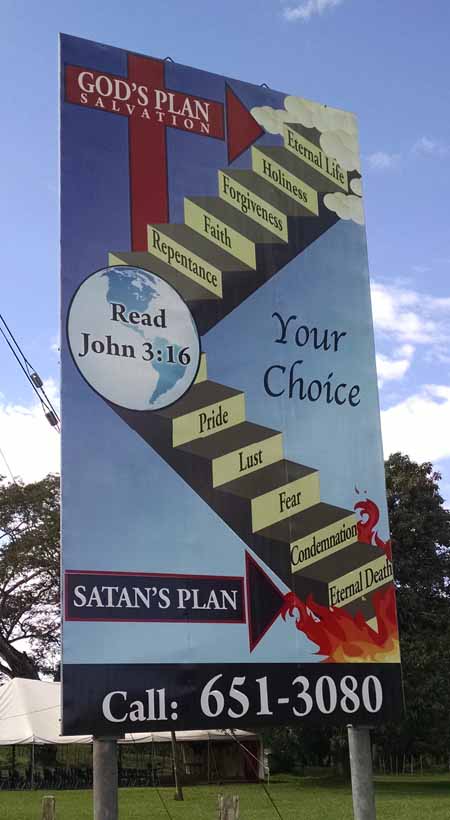
A sign along the Western Highway somewhere on today's drive.
(Click to enlarge.)
For linking purposes this article's URL is:
http://asecular.com/blog.php?141229 feedback
previous | next |







